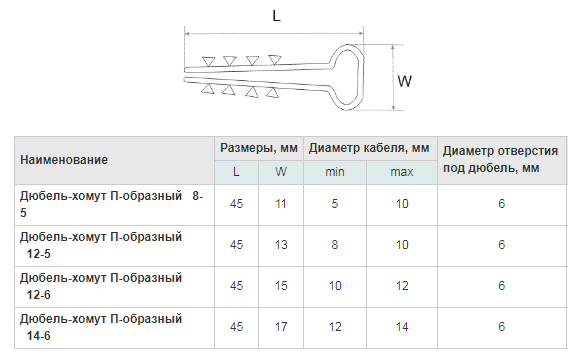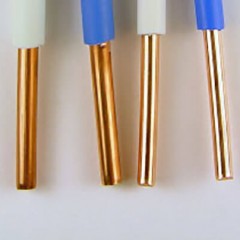Types of clips for attaching wires
Clips with a clove
Designed to secure a wire or cable with a diameter of 6 mm to 14 mm. They are used for mounting power and lighting circuits, as well as telephone and network computer lines. Made of heat-resistant and wear-resistant polypropylene, capable of operating at temperatures from -5 ° C to + 140 ° C. Mounting to a wall or ceiling is done with a nail included in the kit. The nail is made of hardened steel, its length varies from 8.1 mm to 14.9 mm. The sizes of clips can vary from 4 to 12 mm (diameter for fastening a round cable). For a flat conductor, two sizes are indicated in the marking, for example, 5.7 * 10 mm. Manufacturers declared the possibility of installing such products on any surfaces except metal. In practice, it’s more convenient to hammer nails into softer materials, for example, wood, drywall, foam concrete, raw brick.
The size of the clamp is selected so that the wire or cable fits tightly into it, allowing slipping only when a noticeable force is applied. Before starting installation mark the route of the wiring. The clamps must be placed at regular intervals. In places of the bend of the track, the clips are located in the immediate vicinity of the bend on both sides of it. After installing the next fastener, the wire or cable should be tightened along the marked path, install the next fastener and hammer in the nail while holding the conductor tight.
There is also a special stapler for attaching brackets. The video below clearly shows how to use this device:
Clips for mounting corrugations or PVC pipes
In the case when the cable or wire is laid in the corrugation or PVC pipe, it is convenient to use elastic plastic clamps - latches, shown in the photo:
They are made by injection molding of plastic, equipped with stiffeners, ensuring the grip strength of the pipe or corrugation. The use of high-quality plastic allows the product to maintain mechanical characteristics in a wide range of operating temperatures. Fastening is done with a self-tapping screw. The size range is represented by clips with installation diameters from 12 mm to 50 mm.A feature of this product are special grooves on the side surfaces of the clip, thanks to which, clamps of different sizes can be combined into blocks when parallel installation of several cable lines is required.
Start work with careful marking of the wiring path. Clips or blocks of them must be fixed at equal distances. If several lines are laid in parallel and the clamps are combined into blocks, there is no need to fix each of them to the wall; it is enough to secure one of three or four connected clamps. Depending on the material of the wall or ceiling, the clamp can be fastened either by directly screwing in a screw (for wood or drywall), or in a pre-drilled hole (for metal or plastic). For installation during installation of the cable clamp on brick or concrete, it is better to use a dowel-nail of the right size. The installation ends with the installation of the pipe in the latch target and a light push to enter the groove, followed by a click. More about how to run a cable through a corrugation, we told in a separate article.
The photo below shows a variant of the clamp fixing the sealed pipes or corrugations. It is equipped with a clasp that provides a more tight fit. The installation of this clamp, as well as the previous one, is performed under the screw.
Decorative clips
Structurally, these products are similar to mounting clamps with studs. Thanks to the decorative form, such clamps allow not only to produce wire mount, but also give the room the desired style, as well as beautiful disguise the wires on the wall. An example of the use of such clamps is presented in the photo below.
Another example of decorative cable clamps is shown in the following photo. These self-adhesive universal clips are mounted on double-sided tape and are designed to fix the cables of the chargers of telephones and computer peripherals. Velcro clips are convenient to place on any smooth surface.
An overview of this type of product is provided in the video:
Cable clip KL
One of the simplest types of fastening wires in the form of a clamp. It is made of plastic or metal. Dimensions of products allow fastening of cables and wires of different sections. The diameter of the clip varies from 5 to 20 mm, the marking is appropriate: KL-5, KL-12, etc.
The simplicity of design, low cost and not very high decorative qualities of such a fastener allow us to talk about its preferred use in installation of hidden wiring, for preliminary fixation of the conductor in the gate.
Dowel clamps
This fastener is designed for mounting a round or flat conductor. With open wiring, they are the least visible of all types of fasteners. Transparent clamps of this design are suitable for wiring of any color. They can be used with hidden wiring, in a strob. They are installed very simply. A hole of the desired diameter is drilled in the wall, the conductor is inserted into the clip, then the clip is inserted into the hole and pushed all the way. The disadvantages include a relatively small fastening strength, and therefore, such clips are used in the installation of relatively light wires and cables.
The dimensions of the dowel clamps for electrical wiring we have provided below:
The video below clearly shows how to use dowel clamps for attaching wires:
So we examined what clips are for wires and cables. As you can see, there are many options for the execution of cable fasteners, so choosing an appropriate option for your own conditions will not be difficult!
It will be useful to read:

















